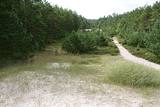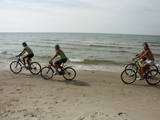| Nr | Name | Beschreibung |
|---|---|---|
|
Die Konditorei MIKO bereitet mehr als 100 Arten von Produkten nach eigenen besonderen Rezepten zu - Kuchen, Piroggen, Eclairs, Kekse. |
||
|
The cafe is situated in the centre of Talsi. |
||
|
Das Café befindet sich im 115. Kilometer der Straße von Vidzeme (A2). Hier kann man am Backprozess des Brotes teilnehmen, das jedes Wochenende organisiert wird. Lettische Innenausstattung. Produkte von lokalen Bauern und Heimarbeitern. Lettische Küche: Hähnchenleber-Salat, Lammfleischsuppe, Suppe mit Fleischbällchen, kalte Suppe, gebratener Wels, geschmortes Schweinefleisch, Kartoffelpfannkuchen, Pfannkuchen mit Marmelade, Quarkfladen, geschichtetes Roggenbrot-Dessert. Das besondere Gericht: Selbstgebackenes Roggenbrot. |
||
|
Traķu pussalas pils austrumu mūrim pieguļ ar mežu apaudzis iespaidīgs pilskalns (uzved koka kāpnes) – t.s. Upurkalns, kurā pirms mūra pils celtniecības stāvējusi koka pils. 1779. g. dominikāņu mūki sagrautās Pussalas pils vietā uzsāka baznīcas celtniecību. Jau vēlāk – 1822. – 1823. g. vienā tās daļā uzcēla dominikāņu klosteri, bet otrā – kapelu. 1990. g. šeit izvietoja Traķu vēstures muzeja administrāciju, bet 2005. g. kapelā izveidoja Sakrālās mākslas izstādi. 2011. g. ēku kompleksā notika vērienīgi rekonstrukcijas darbi. |
||
|
Dodieties ekskursijā, lai gūtu ieskatu lauku profesijā un dzīvesveidā, kā arī iegūtu jaunus iespaidus un labu atpūtu visai klasei. Ekskursijas laikā apmeklējiet podnieku, kurš skolēniem māca, kā praktiski darboties ar rokām, kā no māla izveidot skaistu darbus ar saviem parakstiem un zīmējumiem. Pēc tam apmeklējiet maiznīcu, kur saimniece piedāvā maizes degustāciju un picu cepšanu. Ekskursijas noslēgumā dodieties uz agro saimniecību, lai redzētu, kā siltumnīcās tiek audzēti tomāti, izmantojot mūsdienīgas fotosintēzes tehnoloģijas. |
||
|
Der Bau der Valmiera–Burg wurde 1283 angefangen. Im Laufe des Nordkrieges (1702) wurde die Burg verbrennt, aber am Ende des 17. Jh. wurden die Außenmauern der Stadt abgebaut. Es sind die Ruinen der Burg und die Reste der anderen mittelalterlichen Befestigungsanlagen erhalten. |
||
|
Contact her in advance, and the landlady here will bake various cakes, pastries, carrot buns and pierogi with various fillings. You can also order smoked fish. |
||
|
Das Restaurant befindet sich im Park von Smiltene: im Tal des Flusses Abuls, in der ehemaligen Brauerei des Landgutes. Nebenan befindet sich die Brauerei von Smiltene, wo Zider hergestellt wird, darum können Gäste diesen Apfelwein und auch einen Hauswein verkosten, der aus einheimischen Beeren hergestellt ist. Lettische Küche: Kalte Suppe, Schweinfleisch mit Zwiebeln, Kartoffelpfannkuchen, geschichtetes Roggenbrot-Dessert, Haferflocken mit Schlagsahne. Das besondere Gericht: Brauhaus: Eine gefüllte Schweinfleischrolle. |
||
|
Haapsalu was once loved by aristocrats who stayed here during summers, nowadays this town is very appealing to its visitors because of its essence - tiny streets, old wooden buildings and promenade. Worth mentioning are also town's SPAs which were one of the reasons why Haapsalu was so popular its earlier years. Interesting enough, the famous composer Tchaikovsky considered this place one of his favorite's for spending the holidays. |
||
|
Am Aussichtspunkt am Schloss Lielauces beginnt ein Stegpfad, der entlang des Lielaucer Sees führt. Es besteht die Möglichkeit, zu angeln und ein Boot zu leihen.
Der See Lielauces befindet sich im Naturschutzgebiet Vīķu Moor.
|
||
|
The farm produces dried pork blood sausage, and other meat products. You can take a tour and purchase the products. |
||
|
Der Turm befindet sich im Gutspark Kiiu. Wurde im ersten Viertel des 16. Jh. errichtet und diente als einen „Schutzraum” für Grundbesitzer. Geöffnet für Besucher und bietet den berühmten estnischen Likör „Kiiu torn” an. |
||
|
Direkt am Meer, nur 20 Autominuten von Pärnu entfernt befindet sich das Kapitänshaus (Kapteni talu), wo die vom Kapitän frisch gefangenen Fische zu leckeren Fischgerichten verarbeitet erden, die man im Sommercafé kaufen oder verkosten kann. |
||
|
Vienīgā baznīca nacionālā parka teritorijā. Tā atrodas Kirblas (Kirbla) ciemā – uz neliela pacēluma, kas Baltijas ledus ezera laikā bijusi sala, kuru no visām pusēm ietvēris ūdens. Kirblas baznīcas pirmsākumi ir meklējami 16. gs. un par tās celtniecību saglabājušies dažādi interesanti nostāsti. Tas ir viens no mazākajiem Igaunijas dievnamiem (29 x 11 m). |
||
|
Der Schießstand – am Parkplatz bei dem Naturpfad, kann ein
aufmerksamer Besucher eine zuwachsende breite Schneise sehen, die vom
Strand bis zur Straße Ventspils – Kolka geht. Dieser Platz wurde in der
Sowjetzeit als Schießlehrplatz benutzt.
|
||
|
Dieser Komplex befindet sich am nördlichen Ufer des zweitgrößten Sees in Lettland – des Sees Razna. Aus den Fenstern des Cafés Kastanis bietet sich eine der schönsten Aussichten auf Seen in Lettland! Lettische Küche: Fischsuppe, Ampfersuppe, kalte Suppe, Gerstengrütze, graue Erbsen mit Speck, geschmorte Schweinerippen mit Kraut, Fischgerichte, hausgemachte Käse und gefüllte Äpfel mit Honig. Das besondere Gericht: Gericht aus geriebenen und gebratenen Kartoffeln mit Fleisch und Zwiebeln. |
||
|
Ein Platz eines alten und bedeutenden Handels- und Handwerkszentrum am linken Ufer des Stausees des Rigaer Wasserkraftwerkes, der sich über den Fluss auf 15 m erhöht. Man nimmt an, dass bei einem kleinen Bach – einer Mündung des Flusses Varžupīte nahe der Wallanlage von Daugava sich ein in den historischen Unterlagen erwähnter Hafen von Semgallen befand. Gemäß gefundenen alten Gegenständen kann man behaupten, dass die Wallburg und eine alte Stadt am Fuße der Wallburg bis zum Ende des 12. Jahrhunderts besiedelt waren, als die Bedeutung von Daugmale von der rasch wachsenden Stadt Riga verringert wurde. Der Fuße der Wallburg ist befestigt. |
||
|
Leichte Kost mit reinem Geschmack, das zu Großmutters Zeit noch alltäglich war, jetzt aber als Privileg der Gourmets angesehen wird. Es werden die gerade für diese Gegend charakteristischen Gerichte angeboten. Dass die Rohprodukte rein sind und aus der nächsten Gegend kommen, ist selbstverständlich. |
||
|
Das geschütze Meeresgebiet „Nida – Pērkone“ ist ein von den biologisch vielfältigsten und für den Naturschutz wichtigsten Meeresgebieten an der offenen Küste der Ostsee. Hier kann man die hervorragendsten Riffe anfinden. Während der Vogelmigration wird das Territorium vom größten Teil der in Lettland festgestellten migrierenden Vogelarten überquert. Das Gebiet ist besonders wichtig zum Schutz vom Gänsesäger und der Zwergmöwe. Es befindet sich gegenüber der Regionen Rucava und Nīca. Die Fläche beträgt 36 703 ha. Das Gebiet überdeckt sich Teilweise mit dem Meeresgebiet vom Naturpark „Pape“ und enthält das Meeresgebiet vom Naturpark „Bernāti“.
|
||
|
Am westlichen Ufer des Cirma Sees erhebt sich die 1830 von Feldsteinen erbaute Kirche. Ein berühmtes Gemälde der Jungfrau Maria, dem Wunderkräfte zugeschrieben werden, macht das Gotteshaus zu einem beliebten Wallfahrtsziel. |
||

















